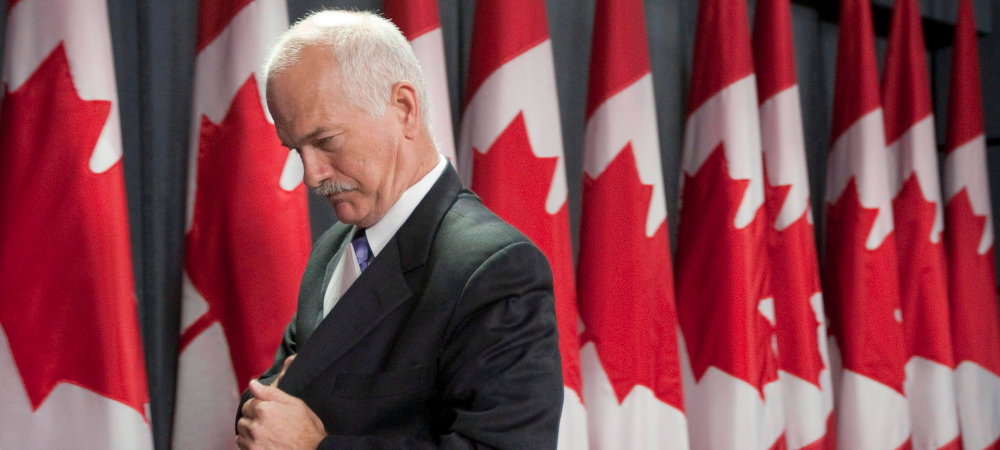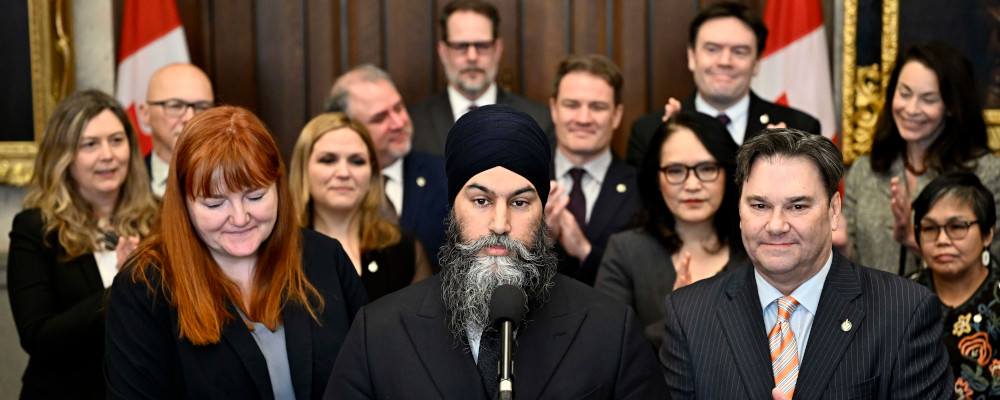Former New Democratic Party leader Jack Layton, who had a real connection with a broad cross-section of Canadians, led his party to its biggest electoral success ever in 2011, gaining official opposition status. It’s been basically downhill since.
In his final letter to Canadians before cancer took his life that same year, Layton urged Canadians to be “loving, hopeful, and optimistic. And we’ll change the world.”
This was once the clarion call of the NDP, a party he helped re-mould from an ideological wasteland of left-wing dogma to a party that middle-class voters could actually imagine in government. Today, the NDP under Jagmeet Singh instead focuses on dividing Canadians and engendering anger.
Taking a look at today’s New Democrats, Layton’s broad appeal rooted in sincerity, warmth, and a cheerful disposition has been replaced by a rather narrow one focused on divisive identity politics. Jagmeet Singh, who assumed the party’s leadership following the ousting of Tom Mulcair at the party’s 2016 national convention, has regrettably taken the NDP in the direction of an ideological and electoral dead end.
Despite losing more than half the 95 seats that the NDP entered the 2015 election with, Mulcair retained a strong showing in Quebec and in rural Canada and clearly had more to give to the party. Instead, he was shunted aside when fifty-two percent of the delegates voted in favour of electing a new leader.
Under Singh’s helm, the NDP has been all but obliterated in Quebec, losing 15 of its 16 seats, and even in the prairies, the birthplace of the party.
Today, the party is almost exclusively an urban party, the product of a leader focused on the interests of those on university campuses and in white-collar government offices.
Singh’s embrace of identity politics was evident during his first day as leader when he struggled to condemn Talwinder Singh Parmar, the mastermind behind the 1985 Air India terrorist attack that killed 329 people, including 280 Canadians. While he eventually “clarified” his position, his waffling quickly showed that he was willing to go where the activist ideological winds would take him.
This trend has continued with Singh’s departure from a balanced approach to the current tensions in the Middle East.
While the NDP has always had problems with antisemitism in its ranks, under Layton and especially under Tom Mulcair there were efforts to rein in the more virulent anti-Israel sentiments in the party.
This has not been the case under Singh.
Long gone is any effort by the party to approach the Israel-Palestine issue with any semblance of concern for how their positioning will affect the Jewish diaspora here at home. Few within the party appreciate the political cover their newfound approach has provided Hamas and its terrorist allies.
The NDP caucus fully embraced activist antisemitism in the wake of Hamas’ October 7th attacks—which took the lives of some 1,200 people and led to the hostage-taking of hundreds more—when they brought a deeply troubling motion in the House of Commons to recognize “the State of Palestine,” among other egregious suggestions. In Parliament, NDP MPs openly wore keffiyehs, a symbol of political resistance against Israel since the Palestinian Revolution in the late 1930s, and enthusiastically adopted by the “from the river to the sea” crowd since October 7.
“Love is better than anger” indeed. Jack Layton is rolling in his grave.
While the challenge of balancing identity politics and the effort of advancing progress for all Canadians has always been a challenge within the NDP, Layton knew how to appeal to activists without allowing them to co-opt the party, thus avoiding the virulently toxic wedge politics the NDP has embraced today.
Layton understood that practical ideas could help middle-class Canadians. Whether it was his push to reinvigorate the automotive sector by investing billions to develop environmentally friendly cars and trucks manufactured here in Canada, or his commitment to work with the provinces to strengthen and eventually double the pension system, Layton frequently saw his job as fighting to build and strengthen the middle class. Not so for Singh, who embraced none of the zeal for a stronger middle class.
Instead, the current NDP leader focuses his attention on populist attacks on the “ultra-rich” and big corporations such as grocery chains, in particular often singling out Loblaws and its head Galen Weston. It is worth noting that Singh’s brother, Gurratan Singh, former Ontario NDP MPP, works for a firm that lobbies for Loblaws competitor Metro.
Millennials and younger voters are clearly desperate for at least one Canadian leader to pay attention to their growing feelings of hopelessness. Yet Singh’s words of support and understanding about affordability ring hollow coming from someone who has a penchant for expensive suits, Rolex watches, and Versace bags.
A recent Abacus Data poll showed voters aged 30-44—the elder millennial cohort, a demographic that typically supports the NDP—have all but abandoned the party. Instead, they are overwhelmingly supporting Pierre Poilieve and the Conservatives. Why? Simple: Singh is offering nothing concrete for millennial and working-class voters to grab onto.
This was brought into sharp relief when in 2023 Singh offered what Mike Moffatt, senior director of policy and innovation at The Smart Prosperity Institute, suggested would “surely push up home prices further and harm many of the people the NDP is trying to help.”
Singh’s idea? Provide a subsidy for people who can’t pay their mortgage.

A party of the working class suggests the best way to support people who want to own a home and build a future is for the federal government to take money from other working-class and low-income Canadians and subsidize homeowners.
You would have never heard this kind of proposal from past NDP leaders, primarily because the party has historically been focused on trying to reduce inequality, not pushing the government to fund it.
Layton’s harshest criticisms were always reserved for a system, not an individual or group. He decried a Canada whose abundant wealth wasn’t being shared. Layton knew inherently that it was Canada’s working class that needed a champion.
Six years into Singh’s leadership of the party, can we say the same? For Singh and his caucus, the agenda is divide and conquer as opposed to build and inspire.
Take NDP MP Charlie Angus introducing a private member’s bill that would seek to control what Canadians see by banning a variety of natural gas ads, even if the information in the advertising is true. A bill so ridiculous that it would have sent Canadians working for oil companies to jail for voicing support for Canada’s oil and gas sector. So egregious was this that it caused Alberta and Saskatchewan NDP MLAs to write a joint letter condemning the proposal.
Singh’s inability to unite people extends deep within the NDP membership, as evidenced by the proposal of Alberta NDP leadership candidate Rakhi Pancholi who advocated for a policy of disassociation from the federal party.1When you sign up to be a member of a provincial NDP, you are automatically also signed up for the federal membership.
The NDP has lost touch with its working-class roots, and Canadians are no longer buying it.
With poll after poll documenting the continued cratering of the Trudeau Liberals, the political stage is once again set for a remaking of the established order. And yet, have Singh and the NDP taken advantage? Hardly. Projections show they would most likely lose seats if an election were held today.
Singh has squandered the goodwill that Layton built and turned the NDP from the so-called conscience of the nation into the very definition of irrelevance.
For party members, it is worth asking: what’s the point in waiting until after the next election to do something about it?





